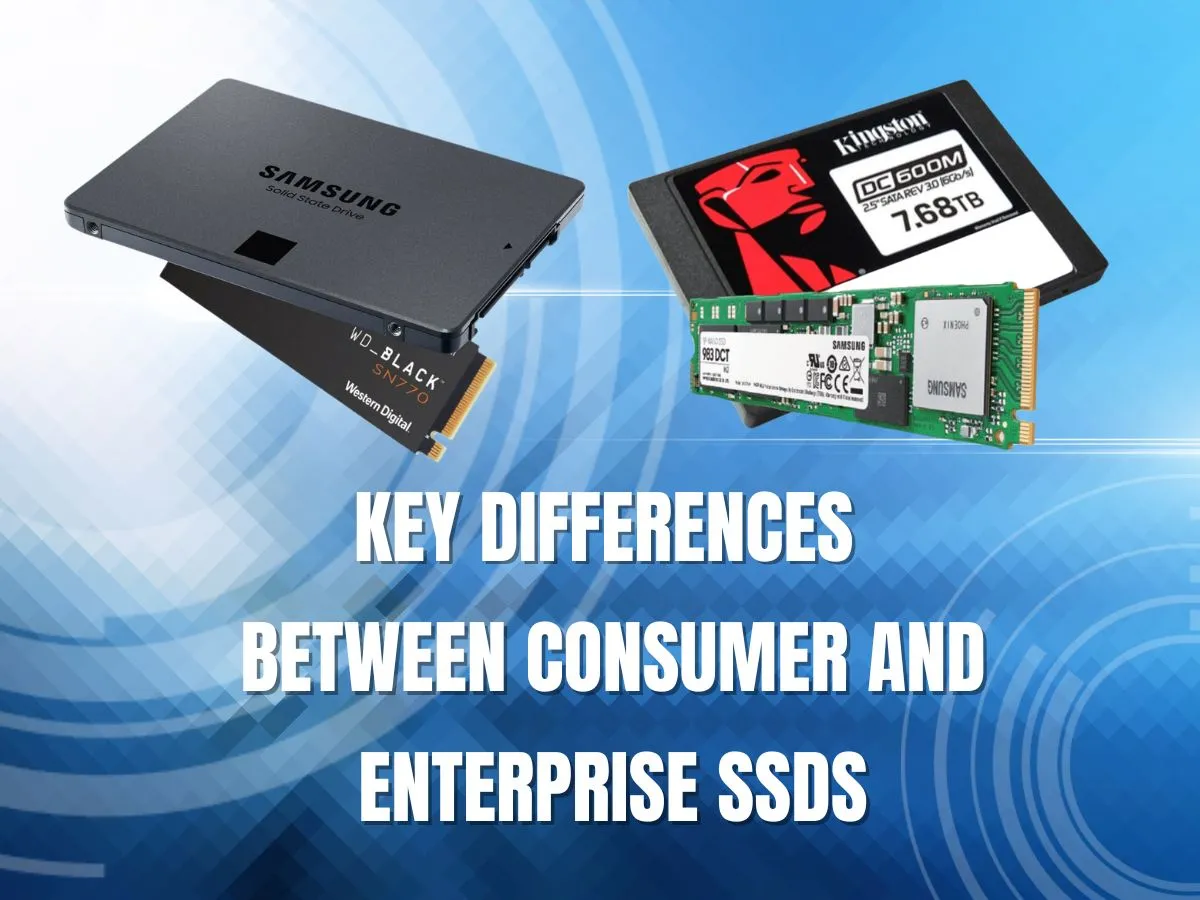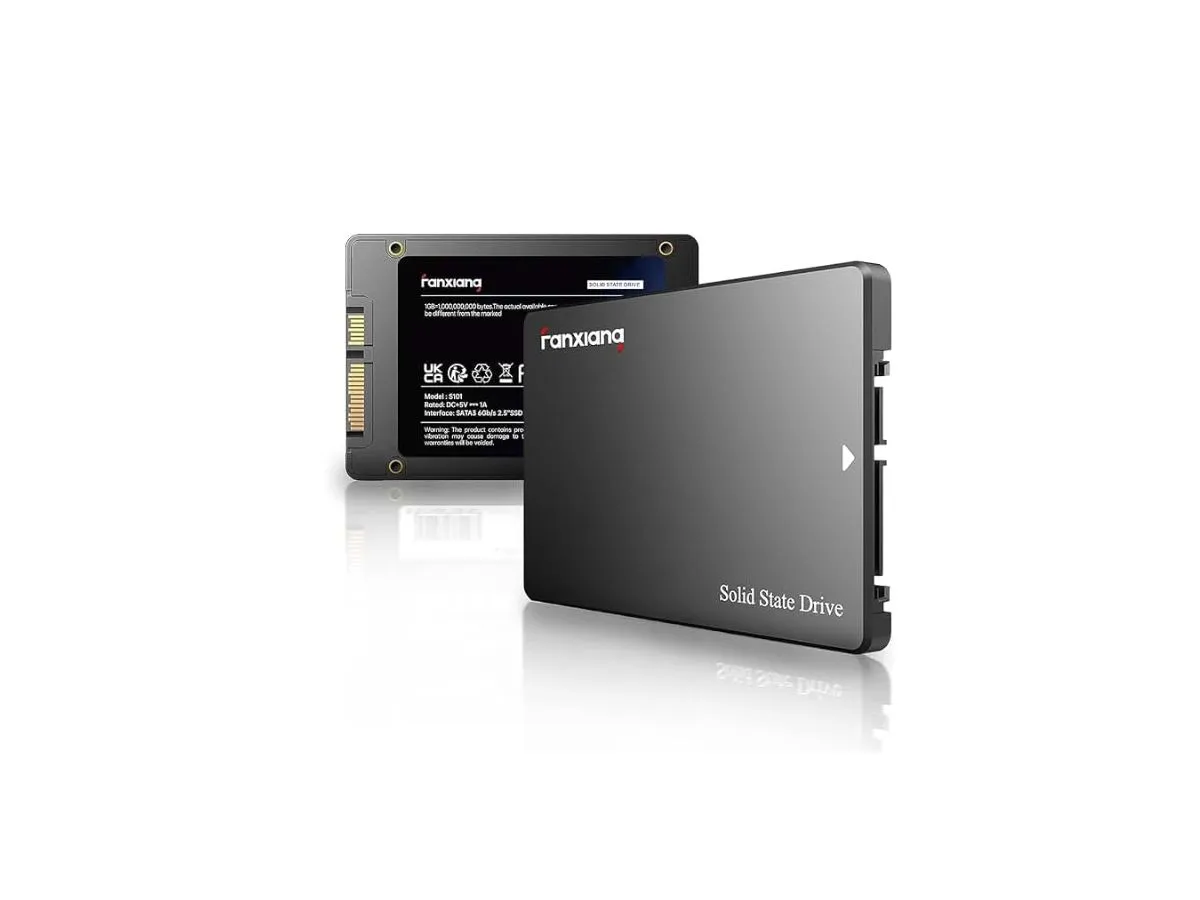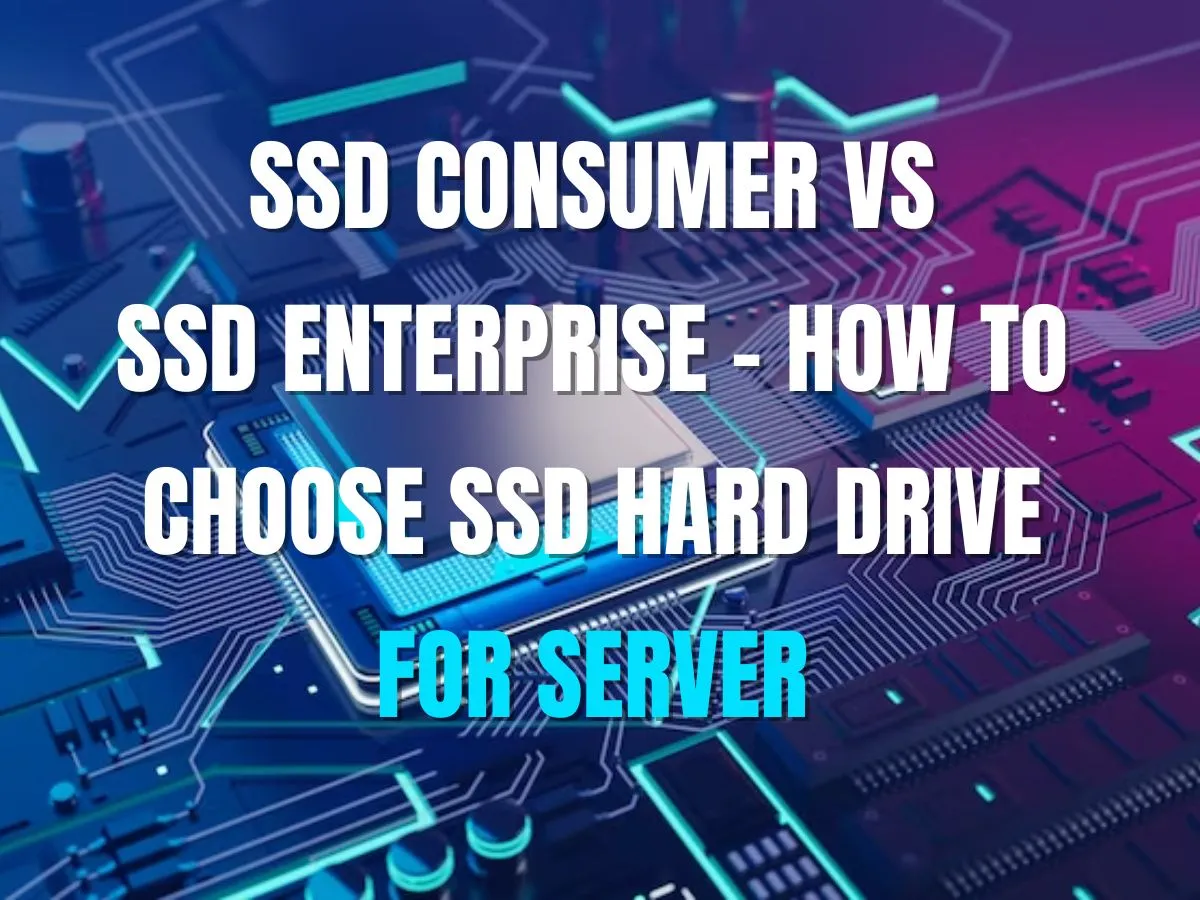When selecting an SSD for your server, understanding the key differences between consumer and enterprise SSDs is crucial. Consumer SSDs are designed for personal use with good performance for everyday tasks, while enterprise SSDs are built for high-demand environments requiring superior performance, durability, and reliability. This guide explores the distinctions between these two types of SSDs, helping you make an informed decision on the best SSD hard drive for your server based on your specific needs and use cases.
1. Understanding ssd types
1.1 Consumer ssds
Consumer SSDs are designed to meet the needs of personal computing. They are optimized for cost-effectiveness and are ideal for tasks such as web browsing, gaming, and multimedia consumption. These drives usually come in the widely-used SATA and NVMe interfaces, which offer good performance enhancements over traditional hard drives but cannot match the industrial-grade requirements needed for business environments.
A typical consumer SSD offers a variety of key characteristics:
- Performance: Average IOPS ranging from 10,000 to 100,000.
- Throughput: About 500 MB/s to 550 MB/s for SATA drives and upwards of 7,000 MB/s for PCIe 4.0 NVMe drives.
- Latency: Average latency between 30 to 100 microseconds.
- Endurance: DWPD (Drive Writes Per Day) from 0.3 to 1, usually expressed in TBW (Total Bytes Written).
- MTBF: Around 1.5 million hours.
- Capacity: Ranges from 120GB to 4TB.
- Over-Provisioning: Usually around 7% to maximize the SSD’s lifespan.
- Features: Basic encryption and TRIM support, minimal to no power-loss protection.
These characteristics make consumer SSDs a cost-effective choice for everyday usage but might not fare well under the stress of continuous data read/write operations found in server and data center environments.
1.2 Enterprise ssds
On the other hand, Enterprise SSDs are specifically engineered for high-performance environments like data centers and servers. They offer superior performance, reliability, and endurance, specifically tailored to meet the rigorous demands of enterprise workloads.
Key characteristics of enterprise SSDs include:
- Performance: IOPS exceeding 1,000,000 to 10,000,000.
- Throughput: Rates that can exceed 10,000 MB/s, especially with advancements like NVMe over Fabrics.
- Latency: Exceptionally low, sometimes as low as 10 microseconds.
- Endurance: DWPD ranging from 1 to 25.
- MTBF: Often exceeding 2 million hours.
- Capacity: Ranging from 800GB to 30TB or more.
- Over-Provisioning: Up to 28% or higher to ensure long-term reliability.
- Features: Advanced encryption, robust power-loss protection, and enterprise-grade optimization features such as end-to-end data protection and wear leveling.
Enterprise SSDs are designed to maintain high performance and reliability in environments that demand constant uptime and data integrity, justifying their higher initial cost through lower Total Cost of Ownership (TCO).
2. Key differences between consumer and enterprise ssds
2.1 Performance
Performance is one of the most noticeable differences between consumer and enterprise SSDs. It’s somewhat akin to comparing a family sedan to a high-performance sports car. While a consumer SSD might perform adequately for everyday tasks, an enterprise SSD is built for speed and handling in demanding environments, capable of supporting multiple high-intensity applications simultaneously.
For instance, typical consumer SSDs offer IOPS ranging from 10,000 to 100,000 while enterprise SSDs exceed this by leaps and bounds, reaching between 1,000,000 and 10,000,000 IOPS. This level of performance is critical for tasks such as real-time data analytics, financial transactions, and virtualization.
When considering throughput, consumer SATA SSDs deliver around 500 MB/s, while PCIe 4.0 NVMe drives can reach around 7,000 MB/s. In stark contrast, enterprise SSDs can surpass 10,000 MB/s thanks to advanced interfaces like NVMe over Fabrics. This bandwidth is essential for operations that require rapid data processing and low latency, often touching as low as 10 microseconds compared to the 30-100 microseconds typical of consumer drives.
Through illustrative comparisons and clear differentiation in metrics, enterprise SSDs present a compelling case for any organization demanding high data throughput and low latency for workload efficiency.
2.2 Endurance and reliability
Endurance and reliability are crucial when distinguishing between consumer and enterprise SSDs. Imagine a marathon runner versus a sprinter – while a sprinter can provide an intense burst of speed, it’s the marathon runner who can maintain a steady pace over longer distances and tougher conditions. Similarly, enterprise SSDs are built to withstand continuous, intensive usage.
One of the key metrics here is DWPD (Drive Writes Per Day). Consumer SSDs generally range from 0.3 to 1 DWPD, meaning they can handle writing 0.3 to 1 full drive’s worth of data per day over their warranty period. In comparison, enterprise SSDs range from 1 to 25 DWPD, making them the clear choice for environments with heavy write requirements.
Further emphasizing reliability, consumer drives average around 1.5 million hours MTBF (Mean Time Between Failures), whereas enterprise SSDs often exceed 2 million hours. This higher reliability is enhanced by advanced over-provisioning that can go up to 28% or more in enterprise drives, aiding in wear-leveling and error correction.
Enterprise SSDs also include robust power-loss protection and advanced encryption features, ensuring data integrity and security even in unexpected conditions. These reliability-focused features are critical for mission-critical environments, underscoring the significant endurance and safety-tailored design.
2.3 Capacity
When it comes to capacity, enterprise SSDs typically offer far greater storage volumes compared to their consumer counterparts. Consumer SSDs generally range between 120GB to 4TB, while enterprise SSDs can provide storage capacities from 800GB up to an impressive 30TB or more.
This broader storage range in enterprise SSDs allows organizations to manage large datasets and complex applications more efficiently. High capacity is particularly beneficial for applications that generate extensive logs and metadata, or for consolidating multiple virtual machines, reducing the need for constant equipment upgrades.
The greater capacity also correlates with higher levels of over-provisioning in enterprise SSDs, enhancing their endurance and reliability. While consumer SSDs typically come with around 7% over-provisioning, enterprise SSDs can push this boundary to over 28% or more, allowing for better wear leveling and performance consistency.
An analogy here is a small household refrigerator vs. an industrial-grade walk-in cooler; while both serve the purpose of keeping items cool, the walk-in cooler is designed to manage much larger quantities and is built to handle significant variations in load, just like an enterprise SSD.
2.4 Special features
Enterprise SSDs come equipped with various special features designed to meet the demand for security, data integrity, and enhanced performance in professional settings.
- Encryption: Enterprise SSDs employ advanced encryption algorithms and security protocols, offering better protection for sensitive data. Consumer SSDs may provide basic encryption, but lack the robust security measures found in enterprise drives.
- Power-Loss Protection: Enterprise SSDs include mechanisms that maintain data integrity during sudden power losses, ensuring that data-in-flight is not corrupted. This feature is crucial for maintaining uptime and data reliability in business-critical applications, a stark contrast to the minimal protection in consumer SSDs.
- TRIM and Additional Optimization: While consumer SSDs usually support TRIM, enterprise SSDs often include additional optimization features that ensure consistent performance and extended lifespan. This optimization is essential for maintaining high throughput and low latency across diverse and demanding workloads.
These advanced features are critical for applications demanding high security, data integrity, and reliable performance. The additional functionalities justify the higher cost as they mitigate risks, reduce downtime, and enhance the overall efficiency of enterprise operations.
2.5 Cost
Understanding the cost implications of both consumer and enterprise SSDs is essential. While consumer SSDs have a lower initial price point, starting approximately at $50, they may lead to higher long-term costs due to less endurance and reliability.
- Initial Cost:
- Consumer SSDs: $50 and up.
- Enterprise SSDs: Can start in the hundreds and go up to thousands of dollars.
- Total Cost of Ownership (TCO):
- Consumer SSDs: Lower initial cost but may incur more long-term expenses due to replacement costs, failures, and potential downtime.
- Enterprise SSDs: Higher initial investment but often lead to a lower TCO due to superior durability, extended lifespan, and fewer interruptions.
Ultimately, the high initial cost of enterprise SSDs is offset by the long-term reliability and lower TCO, especially when considering the potential losses associated with data breaches, power failures, or hardware downtimes in critical server environments.

3. Use cases for enterprise vs consumer ssds
3.1 Enterprise ssds use cases
Enterprise SSDs are purpose-built for a variety of high-intensity applications demanding superior performance and reliability. They excel in environments where high workloads, data integrity, and 24/7 uptime are non-negotiable.
- Database Management: Enterprise SSDs are essential for transactional databases and running complex queries. They offer high IOPS and low latency, making them perfect for environments where quick data retrieval and high-speed analytics are necessary.
- Virtualization: Virtual desktop infrastructure (VDI) and server virtualization benefit greatly from enterprise SSDs due to their consistent performance and ability to handle the randomized I/O patterns typical in virtualized environments.
- Real-Time Analytics: Solutions involving real-time data processing and analytics, such as Internet of Things (IoT) applications, require the reliability and speed of enterprise SSDs to manage data streams and perform on-the-fly analytics.
- Content Delivery Networks (CDNs): While some might think CDNs require high endurance, they are usually more in need of read-heavy, low-latency storage, which makes enterprise SSDs suitable despite some models opting out of power-loss protection.
These use cases showcase the necessity of investing in enterprise SSDs for scenarios where performance, reliability, and data integrity could directly impact the business outcomes.
3.2 Consumer ssds use cases
Consumer SSDs, while not built for intense workloads, still play a vital role in everyday computing tasks. Their cost-effectiveness makes them suitable for a variety of less demanding applications.
- Personal Computing: Ideal for desktop and laptop usage, providing significant speed improvements over traditional HDDs for tasks like booting, application launching, and file transfers.
- Gaming: Enhances the gaming experience by reducing load times and improving overall system responsiveness. Large game files benefit from faster access speeds provided by SSDs.
- Multimedia Consumption: Consumer SSDs are suitable for storing and playing high-definition media files, offering a superior user experience with reduced load times and seamless playback.
- Small Office/Home Office (SOHO): Appropriate for light business tasks such as word processing, spreadsheets, and email management. They deliver quick access to frequently used documents and improve productivity.
These use cases highlight how consumer SSDs fit well into the regular routines of personal computing, balancing performance with cost for casual to moderate workloads.
4. How to choose the right ssd for your server
4.1 Assessing needs
The first step in choosing the right SSD for your server is to clearly define your specific requirements. Assessing your needs helps tailor the selection to ensure the SSD can handle the targeted workload efficiently.
Key questions to consider include:
- Type of Workload: Are you running high-intensity, data-heavy applications, or is it more of a general server setup?
- Data Write Frequency: How often will you be writing data to your SSD? This assessment will guide you to the appropriate level of endurance.
- Data Protection and Security: What level of data integrity and encryption do you require? High-security environments may necessitate the advanced features in enterprise SSDs.
- Capacity Needs: How much storage do you currently need, and will you need additional capacity in the near future?
- Performance Requirements: Evaluate the IOPS, throughput, and latency demanded by your workloads to pick an SSD that aligns with these metrics.
By evaluating and understanding these factors, whether you need the superior reliability and performance of enterprise SSDs or if a high-capacity consumer SSD would suffice, you can make an informed decision effectively meeting your needs.
4.2 Budget considerations
While evaluating the initial cost is crucial, it’s equally important to consider the Total Cost of Ownership (TCO). Enterprise SSDs are more expensive upfront but can lead to savings over time due to their durability and reduced chances of failure.
- Initial Costs:
- Consumer SSDs: Generally cheaper, starting at around $50.
- Enterprise SSDs: Range from hundreds to thousands of dollars.
- Maintenance and Longevity:
- Long-term savings in enterprise SSDs come from their reduced failure rates, lower downtime, and extended lifespan.
- Failure Costs:
- Economic implications of data loss, downtime, or hardware replacements are minimized with enterprise SSDs.
Balancing immediate budget constraints against potential long-term savings is key to a judicious investment, especially in mission-critical applications demanding utmost reliability.
4.3 Future-proofing
Future-proofing your SSD choice involves planning not just for current needs but anticipating future requirements. Choose an SSD that has the capacity and performance headroom to cope with upcoming demands.
- Capacity: Consider higher storage options that can accommodate data growth.
- Performance: Opt for higher IOPS, throughput, and lower latency to support future workloads.
- Compatibility: Ensure the SSD is compatible with existing and future server hardware.
- Technological Advancements: Keeping abreast with emerging technology like NVMe over Fabrics can provide cutting-edge performance enhancements.
By focusing on future-proofing, you can extend the life and usability of your investment, mitigating the need for replacements or upgrades in the short- to medium-term.
5. Technologies behind ssds and the best applications
5.1 Nand types
Understanding NAND types is essential in discerning how an SSD will perform and endure different workloads:
| NAND Type | Bits Per Cell | Performance | Endurance | Cost | Use Case |
|---|---|---|---|---|---|
| SLC | 1 | Excellent | Excellent | High | Industrial, Enterprise |
| MLC | 2 | Very Good | Good | Moderate | High-Performance Consumer, Some Enterprise |
| TLC | 3 | Good | Moderate | Affordable | General Consumer |
| QLC | 4 | Adequate | Lower | Very Affordable | Cost-Sensitive Consumer, Low-End Storage Applications |
Analyzing these NAND types helps select the SSD that best fits the specific performance, endurance, and budgeting needs.
6. Interfaces and form factors in consumer and enterprise ssds
6.1 Interfaces
Interfaces define how SSDs communicate with the system:
| Interface | Typical Use | Throughput | Latency | Common Variants |
|---|---|---|---|---|
| SATA | Consumer/Enterprise | up to 600 MB/s | Moderate | SATA III, SATA II |
| PCI-Express (PCIe) | High-Performance | 1 GB/s to 7 GB/s+ | Low | PCIe 3.0, PCIe 4.0 |
| SAS | Enterprise | up to 12 GB/s | Very Low | SAS-2, SAS-3 |
Choosing the right interface is crucial depending on performance necessities and server capabilities.
6.2 Form factors
Form factors influence SSD placement and installation within servers:
| Form Factor | Description | Typical Usage |
|---|---|---|
| 2.5-inch | Standard size, versatile | Both Consumer and Enterprise |
| M.2 | Compact, high-performance | Laptops, High-End Consumer, Servers |
| U.2 | Larger, enterprise-focused | Enterprise NVMe SSDs |
| PCIe Card | Slot-based, high throughput | High-Performance Enterprise |
| mSATA | Miniaturized, legacy systems | Older Laptops, Embedded Systems |
Understanding these forms speeds up decision-making complying with physical and performance requirements of the server environment.
7. How to choose ssd for server
Adopting a mindful approach to select the right SSD involves:
- Identify Workload Demands: Analyze IOPS, throughput, and endurance needs.
- Evaluate Capacity Requirements: Plan for data growth, ensuring ample storage.
- Factor in Special Features: Assess the necessity of encryption, power-loss protection, and other data integrity features.
- Determine Budget: Balance initial investment with potential Total Cost of Ownership.
- Consider Future Scalability: Select SSDs that provide adequate headroom for future performance and capacity needs.
- Check Compatibility: Ensure the SSD interfaces and form factors align with existing infrastructure.
This well-rounded, thoughtful approach ensures an optimized balance of performance, reliability, and cost-effectiveness for your server setup.

8. Frequently asked questions
- What is the primary difference between consumer and enterprise SSDs?
- Consumer SSDs are designed for personal computing, prioritizing cost-effectiveness over extreme performance and endurance. Enterprise SSDs, conversely, offer superior performance, reliability, and endurance suitable for high-intensity data center and server workloads.
- Why do enterprise SSDs have higher endurance than consumer SSDs?
- Enterprise SSDs incorporate advanced engineering with stronger error correction, robust power-loss protection, and extensive over-provisioning, making them apt for continuous, heavy write operations.
- Are there cost benefits to choosing enterprise SSDs over consumer SSDs?
- Despite higher initial costs, enterprise SSDs often present a lower long-term Total Cost of Ownership (TCO) due to reduced failures, lower downtime, and extended lifespan.
- Can consumer SSDs be used in servers?
- While they can be used, consumer SSDs may not withstand the rigorous demands and high-intensity data handling typical in server environments, often leading to increased maintenance and potential data integrity risks.
- What future-proof factors should be considered when choosing an SSD for servers?
- Capacity for data growth, performance for emerging technologies, endurance for prolonged heavy usage, compatibility with ongoing hardware advancements, and support for future interfaces and form factors are critical considerations.
9. Conclusion
Choosing between consumer and enterprise SSDs depends largely on the specific needs of your server environment. While consumer SSDs are cost-effective and suitable for light to moderate workloads, enterprise SSDs are engineered for peak performance, reliability, and endurance, tailored explicitly for high-intensity, mission-critical applications.
By assessing workload demands, evaluating capacity requirements, considering special features, balancing budget constraints, and planning for future scalability, you can make a well-informed decision, ensuring that your selected SSD meets both current and future data management needs efficiently.
Ultimately, the additional investment in enterprise SSDs can significantly lower long-term costs and risks, providing a robust, durable, high-performance solution that enhances operational efficiency and data integrity, essential in a data-driven business landscape.
>> You may be interested in: What is DDR5 RAM? Comparing DDR5 RAM and DDR4 RAM
For more insights into the latest technology trends and hardware reviews, stay tuned to our blog. If you have any questions or need personalized advice, feel free to reach out to our support team.
CATEGORY:Knowledge

